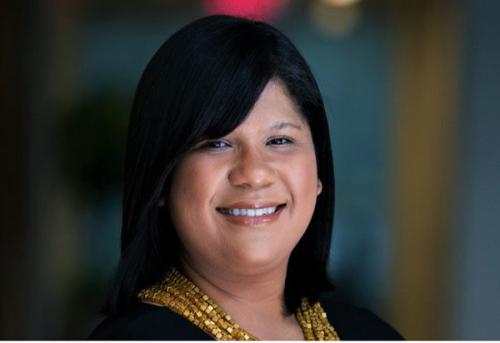How city budgets can help equity as well as fiscal health

The early days of the pandemic were unlike anything anyone’s ever seen—and not only from a public-health perspective. City budgets were nearly wiped out overnight, with lockdowns eliminating revenues from hotels, restaurants, parking, and other sources. Budget and finance officers knew they needed to take quick and decisive action and, at the same time, they needed to do so in ways that that didn’t disproportionately impact communities already in need.
It was a seminal moment, says Lourdes Germán, a public finance expert who serves as Director of the Public Finance Initiative and also teaches at the Harvard University Graduate School of Design. “It was the height of COVID, before vaccines, and a lot of cities’ revenues were deeply impacted,” she says. “And the question was: How do we enable cities to make decisions that are not going to fall on the backs of the underserved?”
Germán was the expert partner who helped direct the City Budgeting for Equity and Recovery program launched by Bloomberg Philanthropies through its What Works Cities initiative. Over the past 14 months, the program brought together finance expertise and data-driven solutions to support cities in implementing new and equity-centered interventions to help them recover from COVID-19. Bloomberg Cities spoke recently with Germán and senior project advisor Dr. Anjali Chainani, who served as the policy director for the Mayor’s Office in the City of Philadelphia from 2016 to 2020, about some of the key strategies city leaders are implementing.
What are some of the key lessons you’re hoping city leaders take away from this program?
Anjali Chainani: Advancing equity can feel very conceptual when it's talked about at a very high level. One thing I'm hoping that city leaders are taking away is the tactical nature of advancing equity. Whether it's programmatic changes, reallocating your budget, developing an equity definition, or standing up a new equity-focused office, there are tactical, measurable ways that cities can advance equity. And there are lots of places to start.
Also, establishing an office of equity as a core function and investing in that is a way to institutionalize this work. Racism is institutionalized. You have to institutionalize new practices to address those historic systemic barriers.
[Read: Meet the chief equity officers]
Lourdes Germán: The biggest piece for me is that there’s a whole spectrum of approaches of what it means to be committed to budgeting for equity. There are multiple entry points. If you’re a city leader and committed to this work, the journey is not cookie-cutter and does not have to look the same for every jurisdiction.
Second, there could be a misconception in some places that equity and fiscal health can't coexist—that there's winners and losers. But that’s not the case when you think holistically about what equity means, and we are seeing exciting examples of that in the program.
As they came into the program, how far along were cities already in their thinking about equity in budgeting?
Anjali: Some cities were at the very beginning. They didn’t have a definition of equity. And then other cities were very mature. Austin, for example, has an Equity Office, an Equity Action Team, and public dashboards to monitor progress. Seattle has had their Racial and Social Justice Initiative since 2014 and developed a Racial Equity Toolkit and Racial Equity Fund. But even they have found new opportunity areas to advance equity through our City Budgeting for Equity and Recovery program. It’s been interesting to see where the cities came into this and the different journeys they’re on.
For cities that are just starting, is creating a definition of what you mean by equity the first step?
Anjali: Having an equity definition is really important, because it's a way of creating shared language. If you don't have that, you can start to see siloed efforts towards equity, where multiple departments have a different definition that they're working from and multiple strategic plans that define it slightly differently. If you really want to create administration-wide buy-in and then have that translate across the executive and legislative branches, having one clear definition is crucially helpful. (Read more here on how cities are defining equity.)
Lourdes: On top of that, so that the definition isn’t just a statement on the city’s website, you need a shared commitment to action. In addition, cities need to have a clear strategy for operationalizing the definition in fiscal processes, and a process for routinized evaluation that enables them to track whether the integration of equity across different areas of public finance is actually making a difference and leading to stronger place-based outcomes.
What are some challenges city leaders run into in this work?
Anjali: Buy-in is critical. It can't just be executive-level buy-in. It has to be lateral and pervasive. Because you're engaging so many different experts from across the city government to change how they are doing their day-to-day business, you can get pushback and there can be resistance.
There’s also a challenge around measurement. For example, Tampa has a program to boost workforce and affordable housing projects to improve economic mobility for residents. It takes time to see that kind of impact. That can be a challenge, because it’s also important to show results to grow buy-in.
Lourdes: Another challenge is sustaining the change once you start. That’s both in terms of internal capacity, and also the cities’ resource environment. The American Rescue Plan Act funds for cities are for a limited time period. What will happen when that goes away?
But it’s also a big opportunity, along with passage of the federal infrastructure bill, to center equity in capital decisions. These laws encourage cities to center equity in how they spend money but there isn’t a roadmap or blueprint to help cities plan for sustained co-investment from other sources to continue the transformative projects that they begin with federal funds. There’s suddenly an opportunity to make significant transformative investments with a different view of your values, but often it may take years to see place-based outcomes actually change. That will often require bringing other sources of funding to the table, which are raised with an equity lens.
What are some examples from the program of cities putting these ideas into practice?
Anjali: Providence, R.I., is exciting. They’re creating a fund balance policy with an equity lens, which we believe is the first one in the country. What they’re working towards is maintaining adequate reserve funds in case there’s a disaster, and they’re explicitly saying in their policy that those funds will be used to protect vulnerable populations. They’ve done a risk analysis around higher rates of flooding with climate change and are taking a data-driven approach. It’s significant to see a city make that level of commitment.
Tampa is another. Mayor Jane Castor has committed to creating 10,000 new units of affordable housing by 2027. What I really like about the city's commitment is that they are also looking to increase home ownership through this for low-income populations. They’re establishing a nonprofit Community Land Trust—it’s a mechanism to prevent home prices in a new development from skyrocketing—and have allocated 20 percent of their ARPA funds to it. They've done it in such a short time and collaborated across city government and with the state in developing this. It's a very inspiring project.
Lourdes: Another great example is Pueblo, Colo. They’ve adopted a scoring matrix to evaluate both their budget decisions and ARPA allocations in terms of how they advance equity. They represent a city that is at an early stage of maturity with their work on equity. And it shows that even in a short time, you can make significant progress, not just adopting a process improvement around equity generally, but also capitalizing on this moment in time with the American Rescue Plan in a very thoughtful way.
These examples show just how many different directions equity in budgeting can take you. What does that mean for city leaders?
Lourdes: There are many entry points, any of which can be a meaningful place to start along a continuum of interventions. For example, most city leaders adopt an approach to budgeting for equity that is focused on integrating equity into the operating budget process. However, budgeting for equity can and should also encompass capital improvement decisions. Equity can and should also be integrated into revenue and investment strategies to guide how money is raised in a city to fund all aspects of government. City leaders should also consider the degree to which their financial management processes reflect strong commitments to inclusive and equitable resident engagement.
[Read: Three ways Austin & Philadelphia are Integrating Equity into the Budget Process]
Anjali: To build on that, the inquiry is really important—the questions that city leaders and their staff ask themselves and one another. Salt Lake City has built into their budget process the questions that all agencies should be asking around equity, from who’s at the table to make the decision, to what are the outcomes we want to see, to are we doing the things that will get us there? That consistent reflection is a way to continue to advance equity, because there is no roadmap.
What innovation tools are helpful for cities in doing this work?
Anjali: A big theme in this program was collaboration—collaboration with people from various backgrounds, expertise, and perspectives. Silos are not the way to advance equitable policymaking. You just can't do it that way.
Having cities learn from one another is also so important. Really being able to talk candidly and explicitly about what you're trying to change. And that takes risk, right? Because efforts can fail, and you have to be able to talk about that.
Lourdes: Having a routinized evaluation process is also critical. The power of data is central to all of this. You can set a vision, but without data city leaders will not know whether an innovative equity process improvement is working and resulting in improved equity outcomes in the city. It’s also important to measure the scale at which social determinants of equity are changing in your jurisdiction—whether that’s at the level of a block, a neighborhood, or citywide. And then to engage in evaluations to identify if you need to change course and modify a strategy to reach desired outcomes.
MORE RESOURCES ON BUDGETING FOR EQUITY:
The impact on cities' credit ratings




